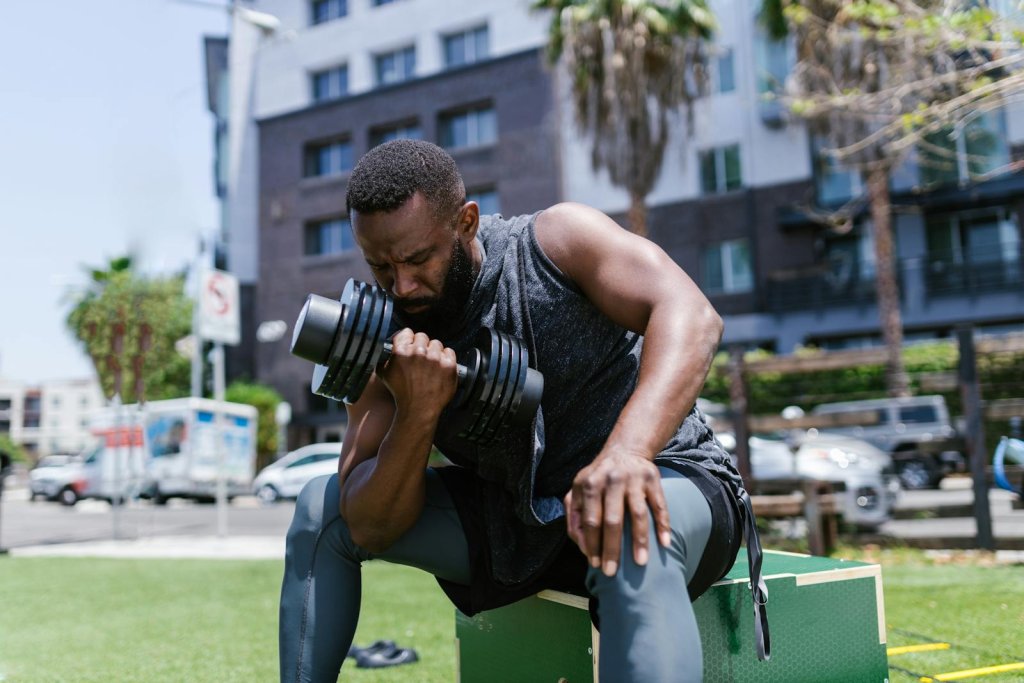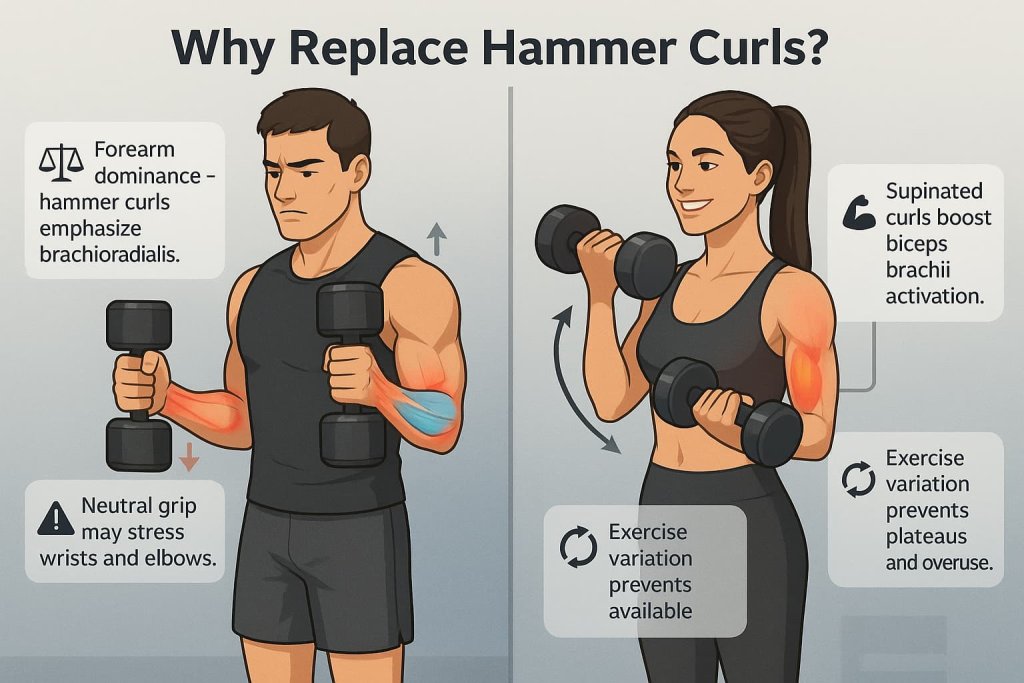Looking for the best hammer curl alternatives to build bigger, stronger arms?
If hammer curls aren’t giving you the arm gains you expected — or if you want more variety in your training — there are several effective exercises that target the same key muscles: the biceps brachii, brachialis, and brachioradialis.

Hammer/neutral-grip curls emphasize the brachialis and brachioradialis, while supinated-grip curls generally elicit higher biceps brachii EMG in comparative studies.
In this guide, you’ll discover 10 scientifically backed alternatives that deliver maximum biceps activation, grip variety, and joint-friendly mechanics — whether you train at home or in the gym.
Why Replace Hammer Curls?
While hammer curls are a great neutral-grip exercise, they aren’t always ideal for every goal or lifter.
Common reasons to look for alternatives include:

- Plateau in biceps size or strength
- Overemphasis on the forearms rather than the biceps
- Wrist or elbow discomfort with the neutral grip
- Need for equipment-free or home-friendly options
- Desire for more targeted activation of the biceps long or short head
Evidence from a systematic review and an umbrella review indicates that varying exercise selection and programming variables (including grip and implement choices) can enhance hypertrophy and help manage overuse by distributing stress across tissues.
10 Best Hammer Curl Alternatives
These 10 hammer curl alternatives build balanced arm strength, targeting the biceps, brachialis, and forearms from multiple angles.
Mix them into your routine to break plateaus, improve muscle definition, and boost overall upper-arm power.
1. Alternating Dumbbell Bicep Curl
Why it works:
This classic variation uses a supinated (palms-up) grip, which increases activation of the biceps brachii — especially the long head — compared to the neutral grip in hammer curls. It promotes greater muscle stretch and “peak” definition while improving arm symmetry by isolating each side.
Muscles worked:
Biceps brachii (long and short heads), brachialis, forearms.
How to do it:
- Stand tall with a dumbbell in each hand, arms fully extended.
- Rotate your palm upward as you curl one dumbbell toward your shoulder.
- Pause briefly at the top for maximum contraction.
- Lower under control and alternate arms.
Trainer Tip:
Focus on a smooth rotation and avoid swinging your torso — keeping the elbows fixed ensures the tension stays in your biceps, not your shoulders.
2. Zottman Curl
Why it works:
The Zottman curl blends a regular biceps curl and a reverse curl in one movement — training both the flexors and extensors of your arms. It’s an excellent way to enhance total arm size and forearm endurance.
Muscles worked:
Biceps brachii, brachialis, brachioradialis, forearm extensors.
How to do it:
- Start with dumbbells at your sides, palms facing forward.
- Curl both weights up simultaneously.
- At the top, rotate your wrists so palms face downward.
- Slowly lower the weights back down in a controlled reverse-curl motion.
Trainer Tip:
Perform the lowering phase slowly (3–4 seconds). The eccentric resistance is what builds serious forearm and grip strength.
3. Reverse Curl
Why it works:
A pronated (palms-down) grip shifts emphasis from the biceps to the brachioradialis and brachialis — helping develop thicker forearms and elbow flexor strength. It’s one of the best forearm-dominant biceps alternatives to hammer curls.
Muscles worked:
Brachioradialis, biceps brachii, forearm extensors.
How to do it:
- Hold a barbell or EZ curl bar with an overhand grip, hands shoulder-width apart.
- Curl the bar upward toward your shoulders.
- Pause briefly, then lower slowly.
Trainer Tip:
Keep wrists straight to prevent strain. Lighter weights with perfect control yield better gains than heavy, jerky reps.
4. Preacher Curl
Why it works:
The preacher curl stabilizes your upper arms against a pad, eliminating momentum and isolating the biceps. It’s ideal for lifters who struggle to feel their biceps during free curls.
Muscles worked:
Biceps brachii (short head focus), brachialis.
How to do it:
- Sit at a preacher bench with arms extended over the pad.
- Hold a barbell or dumbbell with palms facing up.
- Curl the weight until your forearms are vertical.
- Squeeze your biceps at the top, then lower slowly.
Trainer Tip:
Avoid fully locking out at the bottom — stop just before the elbows straighten to maintain constant tension.
5. Incline Dumbbell Curl
Why it works:
Performing curls on an incline bench places your arms behind your body, creating a deep stretch in the biceps long head. This stretch leads to improved muscle growth and definition over time.
Muscles worked:
Biceps brachii (long head), brachialis, forearms.
How to do it:
- Sit on a 45° incline bench with a dumbbell in each hand.
- Let arms hang naturally, palms facing forward.
- Curl both weights up simultaneously without moving your upper arms.
- Lower under control to the starting position.
Trainer Tip:
Keep shoulders relaxed and avoid letting elbows drift forward — this ensures the long head remains under tension.
6. Concentration Curl
Why it works:
This isolation exercise is proven to deliver high EMG activation of the biceps brachii, making it one of the most effective single-arm builders for definition and control.
Muscles worked:
Biceps brachii (short head), brachialis.
How to do it:
- Sit on a bench and lean slightly forward.
- Rest your elbow on your inner thigh with a dumbbell in hand.
- Curl the dumbbell up toward your shoulder, keeping the upper arm fixed.
- Lower slowly and repeat.
Trainer Tip:
Focus on squeezing your biceps at the top — use a full range of motion and slow tempo for maximum hypertrophy.
7. Cable Rope Curl
Why it works:
Unlike free weights, cables maintain constant tension throughout the movement, stimulating more consistent muscle activation and growth.
Muscles worked:
Biceps brachii, brachialis, forearms.
How to do it:
- Attach a rope handle to a low pulley on a cable machine.
- Grab the ends with palms facing each other (neutral grip).
- Curl upward until your hands are near your shoulders.
- Split the rope apart slightly at the top before lowering slowly.
Trainer Tip:
Keep your core tight and avoid leaning backward — tension should remain entirely on your biceps.
8. Chin-Up (Underhand Grip)
Why it works:
This compound move builds biceps and back strength simultaneously. Chin-ups activate the biceps brachii to a similar degree as isolation curls.
Muscles worked:
Biceps brachii, latissimus dorsi, brachialis, rhomboids.
How to do it:
- Grip a pull-up bar with palms facing you, shoulder-width apart.
- Pull yourself up until your chin clears the bar.
- Lower slowly to a full hang position.
Trainer Tip:
If bodyweight chin-ups are too difficult, use an assisted pull-up machine or loop a resistance band around the bar for support.
9. Barbell Curl
Why it works:
The barbell curl remains a foundational strength and mass builder for the entire biceps. It allows for progressive overload with stable form.
Muscles worked:
Biceps brachii (long and short heads), brachialis, forearms.
How to do it:
- Stand holding a barbell with palms facing upward, shoulder-width apart.
- Curl the bar toward your shoulders while keeping your elbows tucked.
- Pause briefly, then lower the bar slowly.
Trainer Tip:
Brace your core and avoid using momentum — keep the movement strict for maximum effectiveness.
10. Cross-Body Dumbbell Curl (Pinwheel Curl)
Why it works:
A perfect hammer-curl alternative, the cross-body motion hits the biceps and brachialis from a unique diagonal angle, improving arm width and forearm definition.
Muscles worked:
Brachialis, biceps brachii, brachioradialis.
How to do it:
- Stand with dumbbells at your sides, palms facing inward.
- Curl one dumbbell diagonally across your body toward the opposite shoulder.
- Lower slowly and switch sides.
Trainer Tip:
Perform the lift under control — the diagonal path increases time under tension, enhancing both muscle size and grip strength.
How to Add These Exercises to Your Arm Day
- Mix 2–3 of these hammer curl alternatives per session — one supinated (e.g., barbell curl), one neutral (e.g., cross-body curl), and one compound (e.g., chin-up).
- Train arms 2–3 times weekly with 8–12 reps per set and 1–2 minutes of rest.
- Focus on slow, controlled reps and progressive overload for lasting results.
Trainer Tip:
Rotate grip styles and equipment weekly to maximize muscle activation and prevent plateaus.
Training Tips for Maximum Arm Growth
- Train biceps 2–3 times per week with 8–12 reps per set.
- Include both neutral- and supinated-grip movements.
- Focus on slow, controlled negatives to maximize time under tension.
- Don’t neglect triceps — balanced arms come from both sides.
- Ensure adequate protein intake (1.6–2.2 g/kg daily) and recovery.
Common Mistakes to Avoid
- Using momentum: Keep elbows fixed; avoid swinging.
- Skipping eccentrics: Lower weights slowly for best growth.
- Overtraining: Rest at least 48 hours between arm sessions.
- No warm-up: Prep shoulders and elbows first.
- Same grip every time: Alternate grips to hit all arm muscles.
Trainer Tip:
Perfect form and recovery beat heavy weight — protect joints and prioritize control.
FAQs
1. Are hammer curl alternatives better for biceps growth?
Yes — supinated-grip exercises like standard or incline curls elicit greater biceps brachii activation.
2. What’s the best home alternative to hammer curls?
Cross-body curls or resistance-band curls are ideal — no gym needed.
3. Can I do these alternatives on the same day?
Yes, combine 2–3 variations targeting different biceps angles for a complete workout.
4. How often should I change my biceps routine?
Every 6–8 weeks to avoid adaptation and keep progress consistent.
5. Are reverse curls good for forearms?
Absolutely — they’re one of the best for brachioradialis and grip strength.
Conclusion
Hammer curls are excellent, but they’re not the only way to build powerful arms.
Mixing these 10 alternatives into your routine ensures balanced muscle activation across the biceps, brachialis, and forearms — leading to thicker, stronger, more aesthetic arms.
Start with 2–3 of these moves per session and focus on perfect form, controlled tempo, and progressive overload.
References
- Shoulder angle & curl EMG (incline vs preacher vs standard)
Oliveira LF, et al. J Sports Sci Med (2009). PMC - Curl variants EMG (barbell, EZ-bar, dumbbell) — practical implications
Marcolin G, et al. Frontiers in Physiology (2018). PMC - Equipment & grip effects (BB vs DB vs cable) on biceps/brachioradialis
Coratella G, et al. Biology (2023). PMC - Chin-up grip variations EMG (supinated, pronated, neutral, rope)
Dickie JA, et al. J Strength Cond Res (2017). PubMed - Training frequency & hypertrophy — meta-analysis (guides 2–3×/week advice)
Schoenfeld BJ, et al. Sports Medicine (2016). PubMed - Frequency under volume-equated conditions — updated review
Grgic J, et al. J Sci Med Sport (2019). PubMed - Eccentric training meta-analysis — supports slow negatives
Douglas J, et al. Sports Medicine (2017). PubMed - Technique & safety (warm-up, form, sensible loading)
Mayo Clinic — “Weight training: Do’s and don’ts of proper technique.” Mayo Clinic
